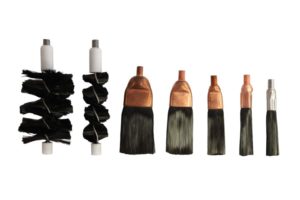How to clean and maintain your weld cleaning brush?
Cougartron product news | Weld cleaning | Tuesday, 19 February 2019
Why is it necessary to clean your weld cleaning brushes?
Thanks to their structure, which is composed of high-quality carbon fiber, Cougartron brushes provide outstanding electrical conductivity during weld cleaning and passivation.
Even though our weld cleaning brushes are manufactured according to strict quality standards, it is very difficult to estimate their longevity.
Among other factors, the life span of Cougartron weld cleaning brushes depends greatly on your workload, production habits, and the type of welds you are working with.
But what can you do to extend their longevity?
One of the safe ways to do this is to correctly maintain and clean your brushes and thus slow down their deterioration.

Proper brush maintenance will not only extend their longevity but will also make them more effective during your weld cleaning tasks. All this will have a positive impact on your profit and help you to reduce costs.
It is proven that with proper care you can extend the life span of your weld cleaning brush even up to 50%. For example, a properly maintained brush will allow you to clean 1230ft of welds instead of 820ft, as found during some of our performance tests.
On the other hand, improper brush care not only reduces their longevity but also adversely affects other components such as cables, wands, and shrouds.
Therefore, the safest way to protect your investment in equipment is to properly maintain it.
The video above shows the most effective way to clean your Cougartron brushes.
For additional tips, see our helpful mini-guide below.
4 useful tips on maintaining your brushes
- Rinse individual brush parts (brush, shroud, and the wand) thoroughly with warm running water after each weld cleaning session and carefully dry, ensuring the brush fibers are straightened. If you do not have access to running water, you can use a bucket with clean water as a suitable alternative.
- If you are using more than one type of weld cleaning fluid, ensure that you have a dedicated brush for each type. Different weld cleaning liquids possess different chemical formulas so it is always better if there is no mixing.
- If the copper threads become tarnished or dirty, clean them using your fingers or a small stainless steel wire brush to ensure good electrical contact. It is important that both the fibers and the brush crimp are clean before each use. This applies to all other parts of your equipment as well.
- Never leave brushes in cleaning fluid – always store them dry in their original (or any other) container. Make sure the storage container is clean to avoid cross-contamination.


 English
English  English (US)
English (US)  German
German  Danish
Danish  Swedish
Swedish  French
French  Polish
Polish  Spanish
Spanish